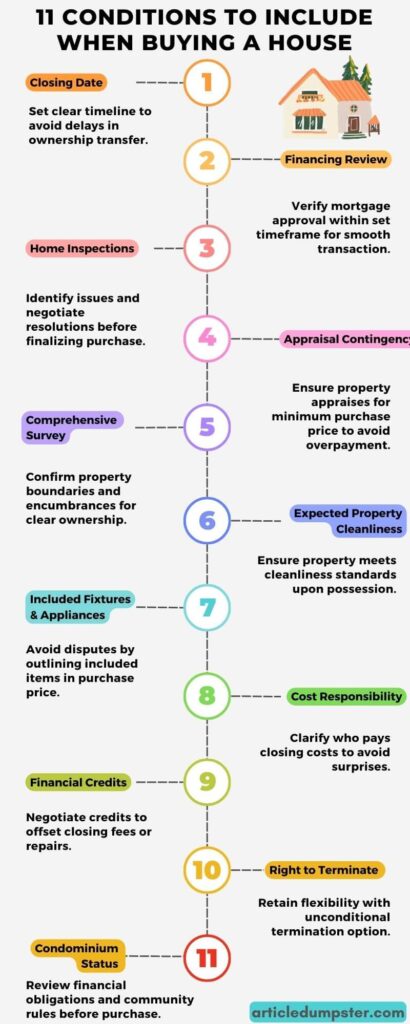Buying a house is an exciting milestone. However, taking the necessary precautions to protect your investment and ensure a smooth purchasing process is essential. While you may be focused on finding the perfect home, have you thought about the conditions you should include in the purchase agreement? These conditions address various aspects of the transaction and can save you from potential pitfalls.
So, what conditions should you include when buying a house? Are there any commonly overlooked aspects that could significantly impact your experience as a homeowner? Let’s see the 11 must-have conditions that should be on your house-buying checklist. Whether you’re a first-time buyer or a seasoned homeowner, these conditions will help safeguard your investment.
11 Crucial Conditions to Include When Buying a House

1. Specify the final closing date for the completion and transfer of property ownership.
One critical condition to include in your purchase agreement is the specification of the final closing date. This date determines when the ownership of the property will be transferred to the buyer.
It is important to establish this date upfront so both parties clearly understand the timeline for completing the transaction.
By specifying the closing date, you can avoid any ambiguity or potential delays in the transfer of ownership.
2. Include a financing review condition to verify approval for a mortgage loan by a predetermined deadline.
When buying a house, it is essential to include a financing review condition in the purchase agreement. This condition allows you to verify that you are approved for a mortgage loan within a specified timeframe.
Including this condition means protecting yourself from any potential issues with securing financing and ensuring you can proceed with the purchase if the loan is approved. It provides the necessary safeguards in case you encounter difficulties securing a loan by a predetermined deadline.
The financing review condition serves as a contingency plan, ensuring that you have the necessary funds to complete the purchase. It gives you the confidence and assurance that the financing is in place before committing to the transaction.
Verifying the approval for a mortgage loan helps you mitigate the risk of encountering last-minute financing issues that could potentially jeopardize the purchase.
Here is an example of how the financing review condition may be included in the purchase agreement:
| Condition: | Financing Review |
| Deadline: | 30 days from the date of acceptance of this agreement |
| Description: | Buyer shall have the right to review and secure approval for a mortgage loan by the specified deadline. The loan approval shall be subject to the satisfactory completion of all necessary financial and credit checks. In the event that the buyer fails to secure mortgage loan approval within the specified timeframe, either party may terminate this agreement without any further obligations. |
This helps ensure a smoother buying process and allows for appropriate measures to be taken in case of any unforeseen financing challenges.
3. Schedule professional home inspections and include time after to negotiate resolution of any issues discovered.
When buying a house, it is crucial to schedule professional home inspections before finalizing the purchase. These inspections help in identifying any underlying issues or potential problems with the property. Hiring qualified inspectors ensures a thorough evaluation of the house’s condition, from the foundation to the roof and everything in between.
Once the inspections are complete, it’s essential to include a condition in the purchase agreement that allows for time to negotiate the resolution of any issues discovered. This condition provides an opportunity to address any necessary repairs or adjustments before closing the deal. By having the chance to negotiate, you can ensure that you are making the right decision and that the seller takes responsibility for any major issues that may affect the property’s value.
During the negotiation process, it’s important to consider the severity of the issues and their impact on the property’s value. Some common issues that may arise during home inspections include:
- Structural issues like foundation cracks or sagging floors
- Roof damage or leaks
- Plumbing or electrical issues
- Mold or water damage
- Pest infestations
Addressing these issues before finalizing the purchase can avoid potential expenses and ensure that the property is in satisfactory condition. It’s important to work with your real estate agent and a professional inspector to evaluate the scope of the issues and determine the appropriate course of action.
Remember, the negotiation process is an opportunity for both parties to reach a reasonable resolution. It’s essential to approach these discussions with an open mind and a willingness to find a mutually acceptable solution. Addressing any issues discovered during home inspections can protect your investment and offer a smooth transition into your new home.
4. Require an appraisal contingency, ensuring the property appraises for minimum purchase price by a set date.
It is vital to include an appraisal contingency in the purchase agreement when buying a house. This condition ensures that the property appraises for at least the minimum purchase price specified in the agreement by a set date. By including an appraisal contingency, you safeguard yourself from paying more than the property’s fair market value.
In the property appraisal process, a professional appraiser assesses property value based on its condition, location, comparable sales in the region, and market trends. The appraiser’s evaluation helps determine if the agreed-upon purchase price aligns with the property’s fair market value.
The appraisal contingency gives you options if the property does not appraise for the minimum purchase price. You can choose to renegotiate the purchase price with the seller depending on the appraised value or, if desired, terminate the agreement altogether without any penalties.
| Benefits of an Appraisal Contingency | Considerations for Appraisal Contingency |
| -Ensures you pay a fair price for the property -Protection against overpaying -Opportunity to renegotiate the purchase price based on the appraised value -Option to terminate the agreement if the property does not appraise for the desired price | -Specify a clear minimum purchase price in the agreement -Set a deadline for the appraisal to be completed -Ensure the contingency language is precise and unambiguous -Review the appraiser’s qualifications and credentials -Understand the potential consequences and next steps if the property does not appraise as expected |
5. Review and approve a comprehensive survey to confirm property boundaries and identify encumbrances.
When buying a house, reviewing and approving a comprehensive survey confirming the property’s boundaries and identifying any encumbrances is crucial. This condition provides you with a clear understanding of the exact boundaries of the property you are purchasing and helps avoid any future disputes.
A survey typically includes the following:
- Property boundaries
- Structures and improvements on the property
- Easements or rights-of-way
- Encroachments
- Boundary disputes with neighboring properties
By including this condition in the purchase agreement, you can ensure that the survey meets your expectations and aligns with any existing property records. It is essential to have a comprehensive survey conducted by a qualified surveyor to provide you with accurate information about the property you are buying.
A thorough review of the survey will help you:
- Confirm property boundaries and ensure there are no encroachments on the land
- Identify any easements or rights-of-way that may affect your use of the property
- Avoid future legal complications or disputes with neighboring property owners
With a thorough survey review and approval, you can have peace of mind knowing that the property’s boundaries are accurately represented and that no unforeseen encumbrances may impact your ownership rights.
6. Specify the expected thoroughly cleaned state of the interior and exterior of the property upon final possession.
When purchasing a property, it is crucial to include a condition in the purchase agreement that specifies the expected cleanliness of both the interior and exterior of the property upon final possession.
This helps ensure that the property is in a thoroughly cleaned state when you take ownership, eliminating the need for any additional cleaning expenses or surprises after moving in.
By setting clear expectations for cleanliness, you can avoid any disagreements or misunderstandings with the seller and ensure that the property fits your standards. This condition provides protection and peace of mind, ensuring that the property is delivered in the agreed-upon condition.
7. Clarification of fixtures, fittings, and appliances that are considered included in the agreed purchase price.
When buying a house, it’s crucial to clearly understand what fixtures, fittings, and appliances are included in the agreed purchase price. This step helps avoid confusion and disagreements between the buyer and the seller.
For example, fixtures can include items such as built-in shelving, light fixtures, ceiling fans, and window treatments. Fittings refer to items like faucets, doorknobs, and built-in cabinets. Appliances can include stoves, ovens, refrigerators, dishwashers, washing machines, and dryers.
To ensure clarity, it’s recommended that the purchase agreement list the specific fixtures, fittings, and appliances that will be included in the sale. By explicitly outlining these details, both parties can avoid misunderstandings and unexpected removals of items assumed to be part of the purchase.
Below is an example table that illustrates the clarification of included fixtures, fittings, and appliances:
| Item | Included |
| Chandelier | Yes |
| Refrigerator | No |
| Built-in Microwave | Yes |
| Washing Machine | No |
By clearly defining what fixtures, fittings, and appliances are included in the purchase price, both buyers and sellers can have peace of mind and ensure a smooth transaction.
8. Outline which party holds responsibility for paying all costs associated with closing and transferring legal title.
When buying a house, it is essential to clarify in the purchase agreement who is responsible for paying the costs associated with the closing and transferring legal title. This condition ensures transparency and avoids potential disputes or unexpected financial burdens during the closing process.
By specifying the cost responsibility upfront, both the buyer and the seller clearly understand their obligations and avoid any last-minute surprises.
Here is a general example to illustrate how this condition works:
- As the buyer, you may be responsible for paying expenses such as title searches, attorney fees, transfer taxes, and any other relevant costs associated with the closing and title transfer.
- On the other hand, the seller may be responsible for paying expenses like real estate agent commissions and any outstanding property taxes up until the closing date.
To further illustrate the breakdown of responsibilities, here is a table outlining the potential costs and the party responsible for paying them:
| Costs | Responsible Party |
| Title searches | Buyer |
| Attorney fees | Buyer |
| Transfer taxes | Buyer |
| Real estate agent commissions | Seller |
| Outstanding property taxes | Seller |
By clearly outlining the cost responsibility in the purchase agreement, both parties can confidently proceed with the closing and title transfer process, knowing what costs they are responsible for. This transparency ensures a smooth and transparent transaction, reducing the potential for misunderstandings or financial disputes.
9. Request potential financial credits or allowances from the seller toward closing fees or required repairs.
Including a condition in the purchase agreement that allows you to request potential financial credits or allowances from the seller can provide financial flexibility and help offset some of the closing fees or required repairs.
By negotiating these credits or allowances upfront, you may be able to lower your out-of-pocket expenses and address any necessary repairs without incurring additional costs. This condition gives you the opportunity to negotiate with the seller and potentially save money during the purchasing process.
- Reduce your upfront expenses
- Lower your closing costs
- Help cover repair or maintenance expenses
- Improve your overall financial position
10. Reserve an unconditional right to terminate the purchase agreement by a date before the scheduled closing.
When entering into a purchase agreement, it is important to have an unconditional termination option as a safeguard. This condition allows you to reserve the right to terminate the agreement without any penalties or consequences under specific circumstances. By including this provision, you can protect yourself from potential issues or changes in circumstances that may arise before the scheduled closing date.
Having an unconditional termination option in the purchase agreement gives you the freedom to reconsider the transaction if unforeseen events occur or if you are no longer interested in proceeding with the purchase. It provides you with an exit strategy and ensures that you are flexible in making decisions based on your best interests.
It is crucial to clearly specify the deadline by which you can exercise this termination option. This date should be set before the scheduled closing to ensure that you have enough time to evaluate the situation and make an informed decision.
11. Obtain condominium status certificates detailing fees, rules, and any liabilities for condominium properties.
When purchasing a condominium, it is essential to obtain condominium status certificates. These certificates provide critical information about the fees, rules, by-laws, maintenance responsibilities, and any potential liabilities associated with the property. They offer a comprehensive overview of the condominium’s financial obligations and regulations, allowing you to make an informed decision before finalizing the purchase.
By including the condition to obtain condominium status certificates in the purchase agreement, you can ensure that you have access to all the necessary information about the property. Reviewing these certificates provides clarity on the financial commitments, such as monthly maintenance fees, special assessments, and reserve funds. Additionally, the certificates outline the rules and by-laws that govern the community, providing insights into restrictions, pet policies, parking regulations, and more.
Considering the significance of condominium status certificates, it is crucial to evaluate their contents carefully. Take the time to review and understand the information presented, ensuring that you are comfortable with the financial obligations and rules associated with the condominium property. These certificates allow you to assess whether the condominium aligns with your lifestyle, preferences, and budget.
Obtaining and thoroughly reviewing the condominium status certificates helps avoid any surprises or unforeseen liabilities. It ensures you have a comprehensive understanding of the property’s financial commitments and community regulations, enabling you to make an informed decision and proceed confidently with your condominium purchase.




